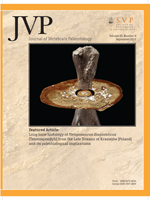The first fossil specimen of the characiform genus Salminus is described here. The material, a threedimensionally articulated head, is very well preserved and allowed us to identify a new species. We could study both outer and inner bones. The specimen was found in the locality Toma Vieja, northeast of the city of Paraná, central eastern Argentina. The bearing horizon is the so-called ‘Conglomerado osífero,’ which is putatively included in the lowermost beds of the fluvial Ituzaingó Formation. The ‘Conglomerado osífero’ is early Tortonian (early late Miocene) in age. Recent species of Salminus are top-ranking pelagic predatory fishes in temperate to tropical lowland freshwaters of South America. The aquatic vertebrate fauna occurring in the bearing bed shows a similar composition to several northern South American units such as the Urumaco Formation (Venezuela, late Miocene) and La Venta Formation (Colombia, middle Miocene).
How to translate text using browser tools
1 November 2012
The First Fossil Species of Salminus, A Conspicuous South American Freshwater Predatory Fish (Teleostei, Characiformes), Found in the Miocene of Argentina
Alberto Luis Cione,
María De Las Mercedes Azpelicueta
ACCESS THE FULL ARTICLE





